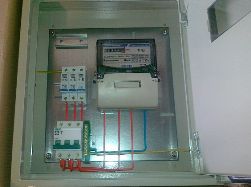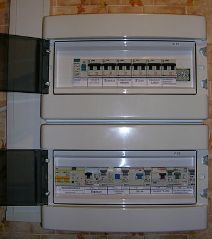Categories: Featured Articles » Electrician at home
Number of views: 59711
Comments on the article: 10
The composition of the home electrical panel
 The place of concentration of all electricians in every house or apartment is house electric shield. It is here, with the help of various equipment, that the distribution of electric energy occurs in your home. And the home electrical panel of a country house is fundamentally different from housing shield only the size and number of devices.
The place of concentration of all electricians in every house or apartment is house electric shield. It is here, with the help of various equipment, that the distribution of electric energy occurs in your home. And the home electrical panel of a country house is fundamentally different from housing shield only the size and number of devices.
The equipment that is part of the modern home electrical panel is modular and is mounted on a DIN rail (more about the features of installing electrical equipment on DIN-rake) This saves space, especially if you take into account the fact that home electrical networks are often three-phase, and there are more than enough powerful household electrical appliances in a country house. For the same reasons, home electrical panels often have several tiers, and the total number of modules of equipment placed in them reaches 36 or more.
This equipment includes:
1. Introductory circuit breaker. The number of poles of the input automaton corresponds to the phase of the network, but often not only phase but also working neutral conductors are broken at the input. In this case, the number of poles of the opening circuit breaker exceeds the number of mains phases per unit. Thus, in a three-phase network, an input circuit breaker can have four poles, and in a single-phase network, two.
In addition, fire safety standards encourage the installation of a protection device against leakage currents at the input to the house with a trip setpoint of 100 mA or more. For reasons of space saving, the role of such a device is usually performed by the same input machines with integrated differential protection.
The current rating of the input automatic machine must correspond to the maximum allowed power, taking into account the phase. For example, in fact, for 10 kW in one phase, the rating of the machine will be 50-63 amperes, and for three phases and 15 kW it can be only 25 amperes.
2. Active energy meter. It occupies a fairly large amount of space - up to 6-7 modules, depending on the brand, manufacturer and the number of phases for which it is designed. If the electricity metering point is put into operation for the first time, and the owner will present the meter to representatives of the energy retail company for sealing, then the meter must have a passport with valid metrological verification.
All meters at the manufacturing plant pass this verification, but it is valid for only one calendar year. Verification of old meters for installation in a new shield is impractical due to the troublesome and expensive procedure. In addition, the old counter may not be suitable for bit depth (number of characters).
How to choose an electric meter?
Installation and installation of electric meters
The most common schemes for switching on single-phase and three-phase electric meters
 3. Devices of overcurrent protection, or, more simply, automatic devices. These devices replaced fuses (plugs). Protect socket circuits, lighting circuits, as well as stationary power supply circuits from short circuits and overload currents.
3. Devices of overcurrent protection, or, more simply, automatic devices. These devices replaced fuses (plugs). Protect socket circuits, lighting circuits, as well as stationary power supply circuits from short circuits and overload currents.
Automatic machines should be selected in accordance with the capacity of the expected load. And if it is not difficult at all with stationary power receivers (you can use the approximate ratio for current I = P * 4.55, where P is the power of a single-phase power receiver in kilowatts, and for a three-phase power receiver, the obtained value should be divided by three more), then for sockets and lighting circuits, it’s difficult to predict the exact load.
Usually, single-pole circuit breakers of the “C” characteristic of 25 amperes are used to protect single-phase outlets, and automatic machines of 10 or 16 amperes are used to protect luminaires.If the power of the lighting circuits is large, then it is better to divide them into several groups protected by such machines.
About electrical protection devices for dummies: circuit breakers
How to choose a circuit breaker for home, apartment
Characteristics of circuit breakers
4. Protection devices against leakage currents, or RCDs. These devices also occupy a precious place in the switchboard, therefore, for reasons of economy, the already mentioned differential circuit breakers with a setting of not more than 30 mA are used instead. Such machines protect against leakage currents, and from increased short circuit currents or overloads.
About electrical protection devices for "dummies": residual current device (RCD)
Protection against leakage currents: RCD and difavtomat
What to choose? RCD or Differential Automatic
5. Zero pads - working (N) and protective (PE). These are solid brass rails with holes for screw clamping of zero wires of different sections. Structurally, zero blocks can be mounted on a common DIN rail, and can be mounted separately, with screws, to the shield body. In a three-phase household network, in the presence of re-grounding, a jumper is installed at the input between the N and PE blocks.
The listed devices are almost mandatory for installation in a home electrical panel. But this list is not necessary. For example, often enough they install in a shield modular surge arrestersprotecting the network from unwanted surges and surges.
Alexander Molokov
Read also on this topic: How to upgrade an old home electrical panel
See also at e.imadeself.com
:
